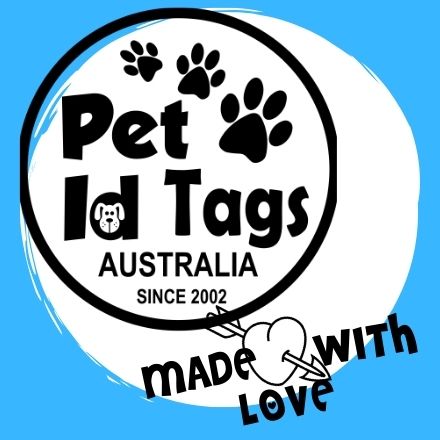Are you a pet owner in Australia? Then you know how important it is to keep your furry friend safe and secure, especially when they're out and about. That's where dog tags come in. They're not just cute accessories for your pet; they're a must-have for every responsible pet owner. But with so many options available, how do you choose the right one?
In this ultimate guide, we'll take you through everything you need to know about choosing dog tags in Australia. From the different materials and styles to the engraving options and sizes, we've got you covered. We'll also discuss the importance of including essential contact information on your pet's tag and the latest trends in pet tags that will make your furry friend stand out.
Whether you have a small Chihuahua or a large German Shepherd, this guide is packed with valuable information to help you make an informed decision. So, if you're ready to find the perfect dog tag for your beloved pet, keep reading!
Importance of dog tags for pet owners
As a responsible pet owner, ensuring the safety and well-being of your furry friend should be a top priority. Dog tags play a crucial role in this by providing a means of identification for your pet. In the unfortunate event that your pet gets lost, a properly engraved dog tag can greatly increase the chances of a safe and speedy return.
Dog tags serve as a form of communication between your pet and anyone who finds them. By including essential contact information on the tag, such as your name and phone number, you make it easier for others to reach out to you in case your pet wanders off. This simple yet effective identification method can save you from unnecessary worry and help reunite you with your beloved pet.
Another benefit of dog tags is that they can indicate important medical information about your pet. If your furry friend has any allergies, requires medication, or has a specific medical condition, including this information on their tag can be a lifesaver in an emergency situation. It allows others to provide the necessary care your pet needs, even if you're not around.
In summary, dog tags are vital for pet owners because they provide a means of identification, facilitate communication between finders and owners, and can convey important medical information. With a dog tag, you can have peace of mind knowing that your pet has a better chance of being returned to you if they ever go missing.
Types of dog tags available in Australia
When it comes to choosing a dog tag for your pet, you'll find a wide variety of options available in Australia. Understanding the different types of dog tags can help you make an informed decision based on your pet's needs and your personal preferences.
One of the most common types of dog tags is the traditional metal tag. These tags are typically made from durable materials such as stainless steel or aluminum, which can withstand wear and tear. Metal tags come in various shapes, including round, bone, and heart, allowing you to choose one that suits your pet's personality.
For those looking for a more stylish option, there are also personalized dog tags available. These tags can be custom-made with your pet's name, your contact information, and even unique designs or logos. Personalized tags not only serve as identification but also add a touch of personality to your pet's collar.
If you prefer a more modern and lightweight option, consider opting for a silicone or plastic dog tag. These tags are often made from flexible materials that are comfortable for your pet to wear. They are also waterproof and easy to clean, making them suitable for active pets that love outdoor adventures.
In recent years, digital dog tags have gained popularity. These tags utilize advanced technology, such as QR codes or NFC chips, to store your pet's information digitally. When scanned or tapped, the tag provides access to a webpage with your pet's details. Digital tags can be a convenient option for pet owners who prefer a high-tech solution.
When choosing a dog tag, consider your pet's size, activity level, and comfort. Some tags may be too heavy or bulky for smaller pets, while others may not be durable enough for active dogs. By selecting a tag that suits your pet's needs, you ensure they can wear it comfortably and without any restrictions.
In conclusion, the different types of dog tags available in Australia include traditional metal tags, personalized tags, silicone or plastic tags, and digital tags. Each type has its own advantages and considerations, so choose one that best suits your pet's needs and your personal preferences.
Engraving options for dog tags
Once you've chosen the type of dog tag that suits your pet, it's time to decide what information to engrave on it. The engraving on your pet's tag should be clear, legible, and include essential contact information to ensure a swift reunion if they ever get lost.
The most crucial piece of information to include on your dog's tag is your phone number. This allows anyone who finds your pet to contact you immediately. It's best to use a phone number that is always accessible and will be answered promptly. If you have multiple contact numbers, prioritize the one you're most likely to answer.
In addition to your phone number, consider including your pet's name on the tag. This personal touch can help create a sense of familiarity and comfort if your pet is lost and feeling scared. Including your pet's name also makes it easier for others to call them by name and gain their trust.
While it's essential to include your contact information and your pet's name, it's generally not recommended to include your home address on the tag. This is to protect your privacy and prevent any potential security risks. However, you can opt to include your city or suburb to give a general idea of your location.
Some pet owners choose to include additional information on their dog's tag, such as an alternate phone number, an email address, or an indication of any medical conditions or allergies. Including this information can be helpful in specific situations, but be mindful of the amount of text on the tag. Ensure that the font size remains legible and the tag doesn't become overcrowded.
When it comes to engraving options, there are various techniques available. Traditional engraving involves etching the information onto the surface of the tag using a sharp tool. Laser engraving, on the other hand, uses a laser beam to create precise and permanent markings. Both methods are effective, so choose the one that best suits your preferences and budget.
In summary, when engraving your pet's tag, include your phone number and your pet's name as essential information. Avoid including your home address for privacy and security reasons. Additional information, such as alternate contact numbers or medical conditions, can be included if desired. Choose between traditional or laser engraving techniques based on your preferences and budget.
Materials used for dog tags
Dog tags are available in a variety of materials, each with its own advantages and considerations. The material you choose for your pet's tag not only affects its durability but also its aesthetics and overall look.
One of the most popular materials for dog tags is stainless steel. Stainless steel tags are known for their durability and resistance to rust, making them an excellent choice for active pets that love outdoor adventures. They are also easy to clean and maintain, ensuring your pet's tag always looks its best.
Another common material used for dog tags is aluminum. Aluminum tags are lightweight, making them suitable for smaller pets that may be sensitive to heavy tags. They are available in various colors and finishes, allowing you to choose one that matches your pet's collar or personal style.
For pet owners looking for a more eco-friendly option, consider tags made from recycled materials. These tags are often made from recycled metals or plastics, reducing their environmental impact. By choosing a recycled tag, you can make a small but meaningful contribution to a more sustainable planet.
If you prefer a more luxurious and stylish option, there are also dog tags made from precious metals such as gold or sterling silver. These tags can be engraved with intricate designs or even set with gemstones, adding a touch of elegance to your pet's collar. However, keep in mind that these tags may require extra care and maintenance to ensure their longevity.
In recent years, tags made from alternative materials such as wood or leather have also gained popularity. These tags offer a unique and natural look, perfect for pets with a bohemian or rustic style. However, consider the durability of these materials and ensure they can withstand your pet's activities without getting easily damaged.
When choosing the material for your pet's tag, consider factors such as durability, weight, aesthetics, and your pet's lifestyle. By selecting a material that matches these considerations, you can ensure your pet's tag not only looks great but also withstands the test of time.
To summarize, the materials commonly used for dog tags include stainless steel, aluminum, recycled materials, precious metals, and alternative materials such as wood or leather. Each material has its own benefits and considerations, so choose one that suits your pet's lifestyle, your preferences, and your desire for durability or aesthetics.
Choosing the right size and shape of dog tags
When it comes to choosing the right size and shape of dog tags, there are a few factors to consider. The size of your pet, their collar, and your personal preferences all play a role in determining the best fit for your furry friend.
For smaller pets, it's important to choose a tag that is lightweight and proportionate to their size. Bulky or heavy tags may cause discomfort or restrict their movement. Consider opting for smaller tag sizes, such as mini or small, and choose lightweight materials like aluminum or silicone.
For larger pets, you have more flexibility in terms of tag size and shape. However, keep in mind that excessively large tags may be cumbersome and make it difficult for your pet to move freely. Choose a size that is noticeable but not overwhelming, ensuring your pet can wear the tag comfortably.
In addition to size, the shape of the tag can also be a consideration. Traditional shapes such as round, bone, or heart are popular choices and can add a touch of personality to your pet's collar. However, if you prefer a more unique or unconventional shape, there are also custom shapes available, including paw prints, stars, or even your pet's favorite animal.
When choosing the right size and shape of your pet's tag, consider their comfort, your personal preferences, and any limitations imposed by their collar. By selecting a tag that fits well and complements their appearance, you can ensure your pet looks stylish while staying safe.
In summary, when choosing the size and shape of your pet's tag, consider their size, collar, and your personal preferences. For smaller pets, opt for lightweight and proportionate sizes, while larger pets have more flexibility in choosing the size. Traditional shapes or custom shapes can add personality to your pet's collar, so choose one that suits their style.
Considerations for personalized dog tags
Personalized dog tags offer a unique way to showcase your pet's identity and add a personal touch to their collar. When customizing your pet's tag, there are a few considerations to keep in mind to ensure it accurately represents your pet and meets your expectations.
One of the most important considerations is the font style and size used for the engraving. Choose a font that is easy to read and legible, even from a distance. Avoid overly decorative or stylized fonts that may sacrifice readability. Additionally, ensure the font size is large enough to be easily seen, especially for people with visual impairments.
If you're including your pet's name on the tag, consider how it will be engraved. Some pet owners choose to have their pet's name engraved in a larger or bolder font to make it stand out. Others may opt for a more subtle engraving, blending the name with other information. The choice ultimately depends on your personal preference and the overall design of the tag.
When it comes to including additional information on the tag, such as alternate contact numbers or medical conditions, consider how it will be displayed. Balancing the amount of text with the available space on the tag is crucial to ensure the engraving remains clear and legible. Avoid overcrowding the tag with too much information, as it may become difficult to read.
Another consideration for personalized tags is the design or logo you choose to include. Many pet owners opt for a simple and timeless design, such as a paw print or a heart. Others may choose to include a unique symbol or even their pet's favorite cartoon character. Whatever design you choose, make sure it reflects your pet's personality and style.
Personalized dog tags offer endless possibilities for customization, so don't be afraid to get creative. However, it's important to strike a balance between personalization and readability. By considering the font style, size, additional information, and design, you can create a personalized dog tag that perfectly represents your pet.
In conclusion, when personalizing your pet's tag, consider the font style and size to ensure legibility. Decide how you want your pet's name to be engraved and whether it should stand out or blend in with other information. Balance the amount of additional information to avoid overcrowding the tag. Choose a design or logo that reflects your pet's personality and style.
Recommended information to include on dog tags
When it comes to the information you should include on your pet's tag, there are some essential details that should always be present. By including this information, you increase the chances of a safe and swift reunion if your pet ever goes missing.
The most critical piece of information to include on your dog's tag is your phone number. This allows anyone who finds your pet to contact you immediately. It's important to use a phone number that is always accessible and will be answered promptly. If you have multiple contact numbers, prioritize the one you're most likely to answer.
In addition to your phone number, consider including your pet's name on the tag. This personal touch can help create a sense of familiarity and comfort if your pet is lost and feeling scared. Including your pet's name also makes it easier for others to call them by name and gain their trust.
While it's essential to include your contact information and your pet's name, it's generally not recommended to include your home address on the tag. This is to protect your privacy and prevent any potential security risks. However, you can opt to include your city or suburb to give a general idea of your location.
Some pet owners choose to include additional information on their dog's tag, such as an alternate phone number, an email address, or an indication of any medical conditions or allergies. Including this information can be helpful in specific situations, but be mindful of the
Where to buy dog tags in Australia
When it comes to dog tags, there is some essential information that every responsible pet owner should include. This information will not only help identify your pet but also ensure their safe return if they ever get lost. Here are some recommended details to include on your pet's tag:
1. Pet's Name: Including your pet's name on the tag is crucial. It will help anyone who finds your lost pet to address them by name, making them feel more comfortable and less scared.
2. Owner's Name: Adding your name ensures that whoever finds your pet knows who to contact.
3. Contact Number: Your phone number is the most critical piece of information to include on the tag. Make sure it is a reliable number that you can be reached at any time.
4. Address: Including your address is optional, but it can be helpful if someone finds your pet near your home and wants to return them directly.
Remember to keep the information concise and legible. Avoid using abbreviations or symbols that may be difficult for others to understand. Now that you know what information to include, let's explore where you can buy dog tags in Australia.
How to properly attach and maintain dog tags
When it comes to buying dog tags in Australia, you have several options. Here are some popular choices:
1. Pet Stores: Many pet stores in Australia offer a wide range of dog tags. You can find them in various materials, styles, and sizes, allowing you to choose the perfect tag for your pet.
2. Online Retailers: Online shopping has become increasingly popular, and dog tags are no exception. There are numerous online retailers that specialize in pet accessories, including dog tags. You can browse through their extensive collections, compare prices, and read customer reviews to make an informed decision.
3. Custom Engraving Services: If you're looking for a personalized dog tag, consider using custom engraving services. These services allow you to create a unique tag with your pet's name, your contact information, and even fun designs. You can find them online or at local specialty shops.
No matter where you choose to buy your dog tag, remember to consider the quality of the material, the durability of the engraving, and the overall design. A well-made tag will not only look good but also last longer. Now that you know where to buy dog tags, let's move on to learning how to properly attach and maintain them.
Conclusion: The peace of mind that comes with having dog tags
Once you have chosen the perfect dog tag for your pet, it's important to know how to attach and maintain it properly. Here are some tips to ensure your pet's tag stays securely in place and remains readable:
1. Choose a sturdy collar: Before attaching the tag, make sure your pet's collar is in good condition. A sturdy collar will provide a secure base for the tag.
2. Position the tag correctly: Attach the tag to the collar using the provided ring or clip. Place it on the side of the collar that faces outward, ensuring that the information is easily visible.
3. Check the fit: Ensure that the collar is not too tight or too loose. You should be able to fit two fingers between the collar and your pet's neck comfortably.
4. Regularly check for wear and tear: Over time, the tag may become scratched or worn. Regularly inspect the tag for any signs of damage or readability issues. If necessary, replace the tag to ensure your pet's information remains clear.
Properly attaching and maintaining your pet's dog tag will help ensure its effectiveness in identifying your pet. Now that you know how to take care of the tag, let's conclude with the peace of mind that comes with having dog tags.



